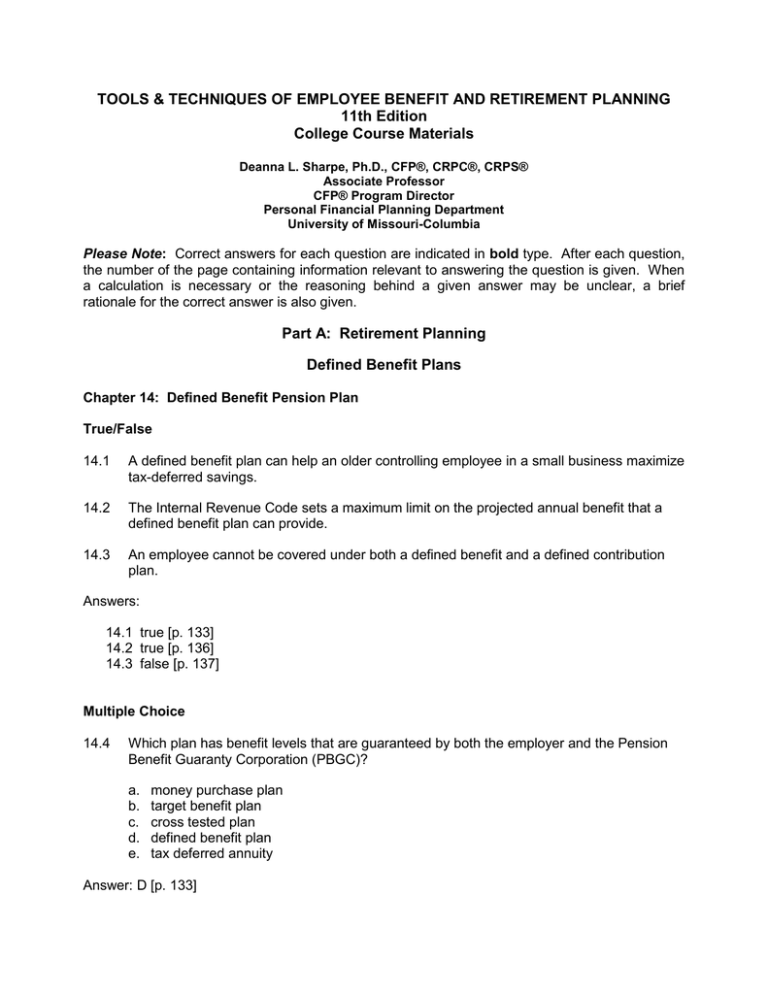TOOLS & TECHNIQUES OF EMPLOYEE BENEFIT AND RETIREMENT PLANNING 11th Edition
advertisement

TOOLS & TECHNIQUES OF EMPLOYEE BENEFIT AND RETIREMENT PLANNING 11th Edition College Course Materials Deanna L. Sharpe, Ph.D., CFP®, CRPC®, CRPS® Associate Professor CFP® Program Director Personal Financial Planning Department University of Missouri-Columbia Please Note: Correct answers for each question are indicated in bold type. After each question, the number of the page containing information relevant to answering the question is given. When a calculation is necessary or the reasoning behind a given answer may be unclear, a brief rationale for the correct answer is also given. Part A: Retirement Planning Defined Benefit Plans Chapter 14: Defined Benefit Pension Plan True/False 14.1 A defined benefit plan can help an older controlling employee in a small business maximize tax-deferred savings. 14.2 The Internal Revenue Code sets a maximum limit on the projected annual benefit that a defined benefit plan can provide. 14.3 An employee cannot be covered under both a defined benefit and a defined contribution plan. Answers: 14.1 true [p. 133] 14.2 true [p. 136] 14.3 false [p. 137] Multiple Choice 14.4 Which plan has benefit levels that are guaranteed by both the employer and the Pension Benefit Guaranty Corporation (PBGC)? a. b. c. d. e. money purchase plan target benefit plan cross tested plan defined benefit plan tax deferred annuity Answer: D [p. 133] 14.5 An employer who wants to reward an employee’s years of service and contribution to the company (measured as salary) would use a defined benefit plan formula based on: a. b. c. d. e. a flat amount a flat percentage based on years of service a flat percentage based on final average pay a flat percentage based on career average pay a unit credit formula Answer: E [p. 134] 14.6 Disadvantages of defined benefit plans include a. employee bears investment risk b. higher installation and administrative costs as compared with a defined contribution plan c. older employees will receive a lower retirement benefit than younger employees d. a and b e. a and c Answer: B [p. 133] Application 14.7 Shannon McDougal will retire December 31 of this year. Shannon has worked for Shamrock Construction for 30 years. During his last 5 years, he earned $40,000, $47,000, $44,000, $46,000 and $48,000. Shamrock’s retirement plan uses a unit credit formula that awards employees 1.5% for each year of service using a financial average of the last 3 years. Shannon’s annual benefit will be: a. b. c. d. e. $19,500 $20,250 $20,700 $21,150 $21,600 Answer: C [p. 134 – In his last three years, Shannon earned an average of ($44,000+ $46,000 + $48,000)/3 = $46,000; $46,000 x (.015 x 30) = $20,700] 14.8 April Showers, age 30, opened the Unique Boutique 5 years ago. April has 5 employees ranging in age from 25 to 42. Earnings have fluctuated. Profits have been made only in the last two years. April: a. should not have a defined benefit plan because it is designed for older business owners b. should have a defined benefit plan because it will maximize April’s tax deduction c. should not have a defined benefit plan because there are a large number of years until the owner or employees retire d. should have a defined benefit plan because the owner can get $1,500 tax credit for establishing a new retirement plan e. should not establish a defined benefit plan because it is not likely April can meet the annual funding requirements Answer: E [p. 133] 14.9 Sherin Blake, owner of Blake Architectural Design, Inc., has hired an actuary to calculate the funding requirement for the company’s defined benefit plan. To make an accurate calculation, the actuary will have to consider: a. b. c. d. e. the estimated retirement age of all employees covered by the plan the formula that Sherin chose to use to calculate employee retirement benefits interest earnings on the fund all of the above only a and b Answer: D [pp. 134-35] 14.10 Mandy Thomas, age 47, is the owner of The Golf Pro Shop. Mandy wants to retire at age 55. The company adopted a defined benefit plan 2 years ago, 3 years after the business opened. Mandy wants to increase the amount that she contributes to her own retirement. Mandy can a. increase the amount without limit b. increase the amount within limits set by the Internal Revenue Code c. increase the amount, but must also contribute to all other company employee accounts by the same proportion d. increase the amount, but maximum benefit will be cut in half because the plan is less than 10 years old e. she cannot increase her contribution Answer: B [p. 137]

